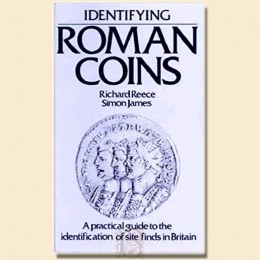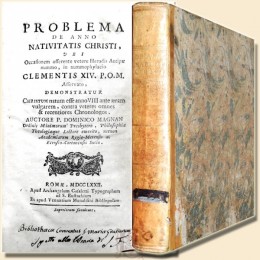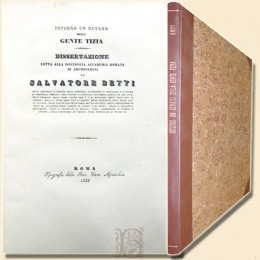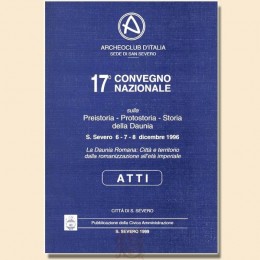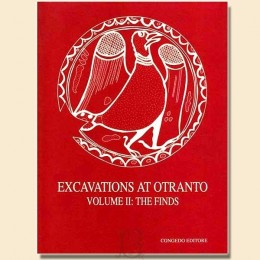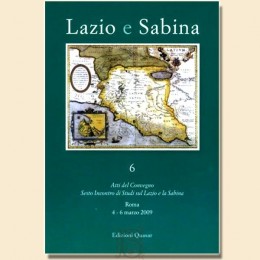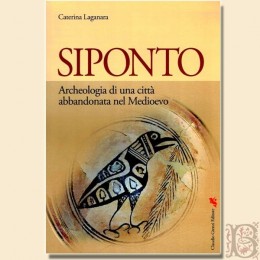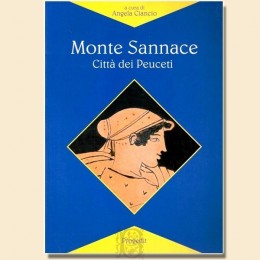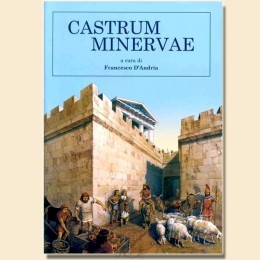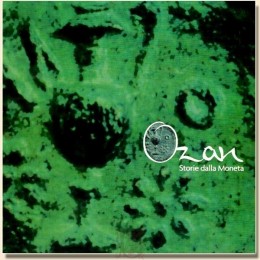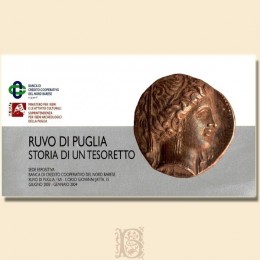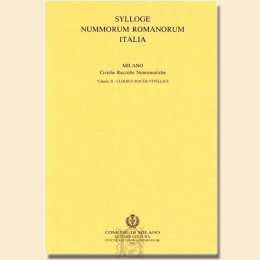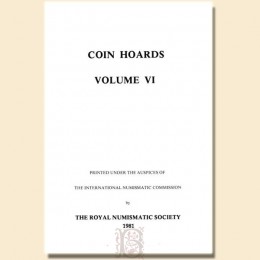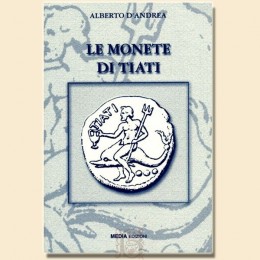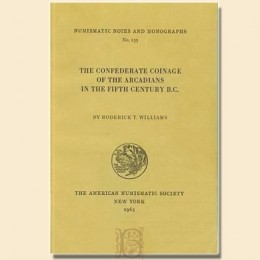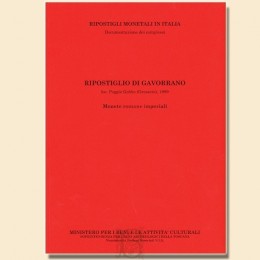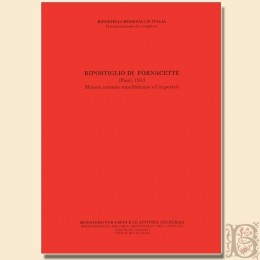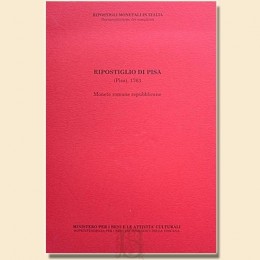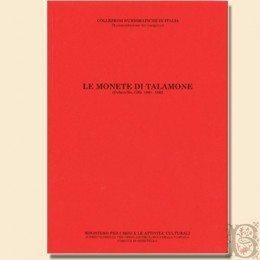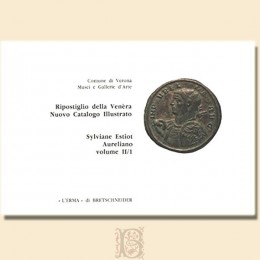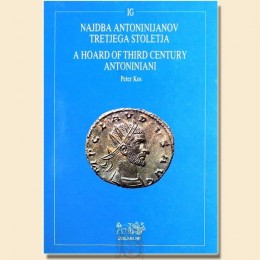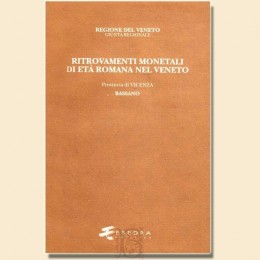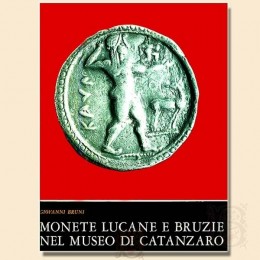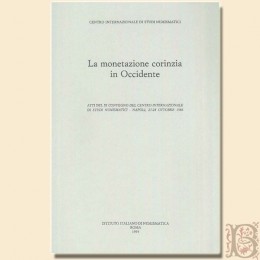Resources
Ancient numismatics
Welcome to the section dedicated to ancient numismatics books of Biblionumis.it, the reference point for enthusiasts and collectors of coins and medals. On the site you will find a wide selection of specialized texts, edited by expert numismatists, that explore the fascinating history of coins from antiquity to the present day. Our books will guide you on a journey through the centuries, telling you the story of ancient civilizations through the evolution of their coins. Whether they are Greek, Roman, Byzantine, modern or contemporary coins, each book is a precious source of knowledge to delve into the historical, artistic and economic details that only numismatics can reveal. We offer works written by internationally renowned numismatists and historians, guaranteeing accurate and detailed content. From coin catalogs with illustrations and detailed descriptions to manuals, each text is designed to satisfy both the expert collector and the novice. You will also find practical guides that will help you evaluate, classify and best preserve your ancient coins. Numismatics is not only a study of the past, but also a current passion that grows every day. Investing in the right books means enriching your knowledge and improving the quality of your collection. Each volume here has been carefully selected to offer you the maximum amount of information and expertise. Our books are essential tools for anyone who wants to delve deeper into ancient numismatics. Thanks to detailed descriptions, high-quality images and contributions from experts, these texts will allow you to navigate the world of ancient coins with confidence. Discover our collection and find the perfect book for you. Whether you are an avid collector or a researcher, our texts will provide you with all the knowledge you need to take your passion for numismatics to the next level. Browse our categories now and enrich your library with fundamental works of ancient numismatics on Biblionumis.it!
-
Identifying Roman coins
€22.00Richard Reece, Simon James, Identifying Roman coins. A practical guide to the identification of site finds in Britain, Seaby, London 1986, pp. 48, richly illustrated, 22 cm, card. and.
New one.
-
Magnan, Problema de anno...
€150.00Magnan, Problema de anno nativitatis Christi, ubi occasionsm offerente vetere Herodis Antipae nummo, in nummophylacio Clementis XIV Dominique Magnan, Problema de anno nativitatis Christi, ubi occasionm offerente vetere Herodis Antipae VIII nummo, in nummophylacio Clementis XIV pom Asservato, demonstratur Christatur anno natum ante aeram vulgarem, contra veteres omnes & recentores chronologos, Apud Archangelum Casaletti Typographum ad S. Eustachium et apud Venantium Monaldini bibliopolam, Romae 1772, pp. 416 with beautiful woodcut frieze on the frontispiece, 7 splendid plates. folded chalcography reproducing coins (plates 3-4 gathered in one), solid coeval binding in half parchment with titles and threads in gold on the title page, plates in marbled paper, artistically sprayed cuts.
Work from the sale of the Cicerone Antiques Bookshop in Rome in May 1996, as evidenced by a small piece of paper taken from the sales price list applied to the rear counterplate.
Minor lacks on the plates, a slight halo of old gora not disfiguring the outer margin of the first cards, two old signs of extinct woodworm that do not affect the text, however the work is overall in a good state of conservation.
Extremely rare.
-
Betti, Around a denier from the...
€55.00Salvatore Betti, Around a denier from the Tizia people. Dissertation read at the Pontifical Roman Academy of Archeology, Typography by Rev. Cam. Apostolica, Rome 1838, pp. 24 with splendid woodcut engraving of the coin examined, 30 cm, beautiful half canvas binding with marbled paper plates and gold titles on the back.
In excellent condition. Very rare.
-
The Roman Daunia: city and...
€25.00National conference on prehistory, protohistory, history of Daunia. San Severo 6-8 December 1996. The Roman Daunia: city and territory from the Romanization to the Imperial Age. Proceedings, edited by Armando Gravina, Archeoclub d'Italia, San Severo 1999, pp. 461, richly illustrated, 24 cm, br. and.
The volume includes interesting contributions including: P. Principe, Teanum Apulum in the Second Punic War: the numismatic documentation.
Other present works: M. Silvestrini, Aecae, Luceria, Arpi: notes on the “gentes” of the three Roman centers of the Celone valley; A. Gravina, Some rural settlements between lower Fortore and southern Gargano. Topography notes; J. Mertens, Notes for the topography of Bovino in Roman times; M. Corrente, Canosa: the Town Hall; L. Di Cosmo, Cases of reuse in the church of Santa Maggiore di Siponto; R. Compatangelo Soussignan, Centuriation without settlers? The case of Canosa in the framework of the royal Apulia et Calabria; L. Pietropaolo, Roman ceramics in Daunia between Romanization and the Late Antiquity. Notes on production and dissemination; L. Notarangelo, Diomede in Turi and Metaponto: for a rereading of schol. to Pind. Nem. X 12; F. Grelle, Settlement forms, territorial planning and municipal organization in the Celone district; J. Mertens, Herdonia, Roman city of Daunia; F. Hilgert, The mosaic floors of the monumental complex of San Giusto (Lucera): preliminary report; L. Marchi, The Venosian district: documents for a Romanization process; E. Casteels, The town hall of Teanum Apulum; O. Dally, The sanctuary in San Leucio di Canosa di Puglia; F. D'Aloia, Imported tableware from late antiquity archaeological contexts from the villa of Agnuli in Mattinata; M. Mazzei, Introduction to the Conference; G. Legrottaglie, The portraiture of the Roman age in Lucera; L. Casavola, The amphorae of the Roman villa of Agnuli (Mattinata-Foggia); M. Mazzei, Lucera; AG Blundo, Roman funerary monuments in Daunia; G. Volpe, For a history of the agricultural landscapes of Roman Daunia; G. Volpe, Ports, routes and trade in the Roman Daunia; M. Chelotti, General picture of imperial property in northern Apulia; MG De Fino, Recent epigraphic acquisitions from Orsara di Puglia (Foggia). Notes for a history of the territory; G. De Felice, Recent excavations at the Roman bridge over the Carapelle (Ordona, FG); M. Mazzei, Siponto: the Colony; L. Todisco, On some ideal types in the statuary of the imperial age in Daunia.
Slight traces of use on the paperback, otherwise in more than good condition.
-
Excavations at Otranto, vol. II,...
€35.00Excavations at Otranto, vol. II, The finds, edited by Francesco D'Andria, David Whitehouse, Congedo Editore, Galatina 1992, pp. 369, richly illustrated, 29 cm, br. and. with dust jacket.
Series of the Department of Sciences of Antiquity. Historical-archaeological sector. University of Lecce, 6. Among the various contributions present is the study by Adriana Travaglini dedicated to coins. Other writings: Introduction, David Wilkinson; Pre-Roman ceramics, Grazia Semeraro; African and micro-Asian ceramics, Maria Teresa Giannotta; Common pre-Roman and Roman pottery, Grazia Semeraro; The oil lamps of the Roman age, Maria Teresa Giannotta; Medieval Domestic Pottery, Helen Pattersona, David Whitehouse; Aphorae for Bulk Transport, Paul Arthur; Roman and medieval glass, Maria Teresa Giannotta; The Small Objects, Martin Hicks, Alison Hicks; The Animal Bones: A Preliminary Assessment of the Stock Economy, Judith Cartledge, Gillian Clark, Valerie Higgins; The Avifauna, Sheila Sutherland; The Fish Remains, Andrew KG Jones, The Marine and Fresh-water Shells, David Reese.
Small signature of possession on the title page.
Very slight traces of use, otherwise in excellent condition.
-
Lazio and Sabina
€50.00Lazio and Sabina, edited by Giuseppina Ghini, Quasar Editions, Rome 2010, pp. 506, richly illustrated, cm 30 br. and.
Proceedings of the Conference of the Sixth Meeting of Studies on Lazio and Sabina, Rome, 4-6 March 2009.
At the top of the title page: Ministry for Cultural Heritage and Activities, Superintendence for Archaeological Heritage of Lazio.
The contribution of numismatic interest should be noted: M. Labate, Black-painted pottery and numismatic finds from the sanctuary of Trebula Mutuesca, some chronological clarifications. Other contributions: MF Rolfo, D. Mancini, L. Salari, A. Zarattini, The cave of “Mora Cavorso” in Jenne (Rome). New research; T. Mattioli, The rock paintings of the cave of the Arch of Bellegra (Bellegra, Rome); P. Pensabene, A. Ottati, New evidence of Doric architecture in Villa Adriana; R. Hidalgo, The so-called Greek Theater of Villa Adriana: issues of identification and interpretation; B. Adembri, GE Cinque, Technique and technology in the Edificio con Peschiera; C. Annunziata, The sculptures of the villas of Colle Nocello, Colle Vitriano and Chiesuola in the ager Tiburtinus; CH Steffensen, B. Tang, C. Trier, Preliminary report of the excavation campaigns of 2007-2008 in the Nomentum area (Mentana, Rome); S. Sgalambro, Trajan's Villa in Arcinazzo Romano: analysis of the planimetric scheme of the lower stalls; MG Granino Cecere, Canteens registered by Nomentum; F. Marino, The church of S. Giovanni del Castrum Statiani in Palombara Sabina; M. Rubini, P. Zaio, The site of the "marked" by God: Palombara Sabina; G. Alvino, Sabina and Cicolano: an update on research; G. Masci, The cities of the Sabines; A. Festuccia, C. Ranieri, Archaic aqueducts and drainage systems in the Ager curense; E. Giummarra, The Sambuco Bridge in Torricella in Sabina. Infrastructures and roads in the ancient age; F. Marzilli, Studies on Casperia; F. Santini, The “hunting companions”: from historical sources to the faunal finds of the villa dei Brutti Praesentes (Scandriglia, Rieti); F. Lezzi, Contribution to the knowledge of Crimes; MF Perotti, The villa cd. Torone near Rieti; F. Squadroni, The territory of Amatrice (Rieti): Roman epigraphs from a border area; R. Cascino, C. Filippone, Funeral kits from the necropolis of Falacrinae (Cittareale, Rieti); E. Farinetti, Cicolano Survey 2008. On the Roman landscape in the plain of Corvaro; V. d'Ercole, A. Martellone, The Sabine necropolis of Montereale (L'Aquila). Colli Albani and Tuscan area: S. Kay, S. Hay, The geophysical investigations conducted by the British School at Rome in Lazio: results and perspectives; E. D'Ambrosio, B. Giaccio, L. Lombardi, F. Marra, MF Rolfo, A. Sposato, The recent activity of the Albano eruptive center between science and myth: a critical analysis of the relationship between the Lazio volcano and the history of the Albanian area; A. De Angelis, F. Altamura, R. Monti, A. Pancotti, The Roman necropolis in Le Zite a Colonna; A. Betori, AL Fischetti, Archaeological finds in loc. Marcandreola in Ciampino (Rome); N. Terrenato, A. Gallone, JA Becker, S. Kay, Orthogonal Urbanism in Gabii. Results of the new geophysical prospecting and prospects for the future; S. Helas, Geophysical prospecting in Gabii: interpretations and perspectives for a study of the walls; A. D'Alessio, M. Di Lieto, M. Maiuro, A. Misiani, Archaeological evidence in the territory of Rocca di Papa (Rome): possible topographical themes and first project contents in support of urban planning tools; L. Attenni, Archaeological evidence in the municipal area of Lanuvio (Rome); etc.
Small signature of possession on the title page.
In excellent condition.
-
Siponto. Archeology of an...
€36.00Siponto. Archeology of an abandoned city in the Middle Ages, edited by Caterina Laganara, Claudio Grenzi Editore, Foggia 2011, pp. 231, richly illustrated, 31 cm, br. and.
The volume includes a contribution by Giuseppe Sarcinelli dedicated to coins. Other contributions are signed by: Gianluca Andreassi, Sabino Edoardo Andriani, Patrizia Albrizio, Gabriella Bozzi, Austacio Busto, Giovina Caldarola, Ida Maria Catalano, Maria Antonietta Catamo, Giuseppe Ceraudo, Marcello Ciminale, Pasquale Corsi, Ginevra d'Onofrio, Giuseppe Daurelio , Giuseppe De Benedetto, Antonella Di Marzo, Emanuela Elba, Giacomo Eramo, Giulia Finzi, Danilo Gallo, Alessandra Genga, Patrizia Gentile, Lorena C. Giannossa, Caterina Laganara, Rocco Laviano, Katia Luzio, Annarosa Mangone, Tiziana Mastracci, Gioacchino Micocci, Raffaella Palombella, Gabriella Passatelli, Comasia Petronella, Daniela Pinto, Daniela Rossitti, Mariangela Sammarco, Maria Siciliano, Tiziana Siciliano, Antonio Tepore, Angela Traini, Anna Maria Tunzi, Adriana Valchera, Inez van der Werf, Enrica Zambetta. Recognize the modalities of the abandonment of ancient Siponto - already a Roman colony in the 2nd century BC, then an early bishop's seat that with alternating vicissitudes through a long history of settlement - and give a face to the city, of which today episodic material traces, albeit marked relevance, essentially reproduce the same landscape known to ancient travelers, is the intent of this study. Making use of the most up-to-date methods on the ground and in the laboratory, the archaeological investigation begins to define the layout of a suburban urban area, close to the northern limit of this important port center on the Adriatic that relives in the memory of today's town of Manfredonia. developed immediately further north, without apparent continuity with the site of the ancient ruins due to the recent formation of the interposed tourist village of Siponto. Walls, houses, religious and funerary spaces, streets with external circulation areas together with the multiple aspects of the lively urban socio-economic reality and the daily life of its inhabitants are returned by a work in progress, part of an integrated program between the Superintendence for Heritage Archaeologists of Puglia and the University of Bari. The results of the first five excavation campaigns, carried out in the form of the school-field starting from 2000, presented in this volume, the realization of which was possible thanks to the funding of several Bodies , are also available in the permanent exhibition set up in the National Museum of the Castle of Manfredonia, where in an unprecedented form past and present coexist in the material remains and in the scientific-technological experimentation that decodes even the most faint traces. A volume that introduces the reader to the intriguing world of circumstantial disciplines, of which archeology is a part, and which offers a valid tool for those who intend to approach it.
Very slight traces of use on the paperback, otherwise in excellent condition.
-
Monte Sannace city of the Peuceti
€25.00Monte Sannace city of the Peuceti, edited by Angela Ciancio, Progedit, Bari 2001, pp. 143, richly illustrated, 24 cm, br. and.
Series: Itineraries.
Monte Sannace is an archaeological site near Gioia del Colle (Bari), where for decades an ancient Peucetian city has re-emerged piece by piece, with the acropolis, the urban structures, the large walls, the civilian settlement in the plain and the sacred and administrative architecture on the top of the hill. But where, at the same time, an environmental park is being preserved, with a nature trail among the green Mediterranean flora of fragni, downy oaks, holm oaks, but also strawberry trees, myrtle, viburn. The union is underlined by this text, edited by Angela Ciancio, director of the park and of the National Archaeological Museum of Gioia. The book intends to disseminate the great mass of scientific writings published so far on the archaeological settlement, updating them with the most recent acquisitions. And to do this it avails itself of the contribution of a series of specialists, who in essential chapters present all the aspects related to the site, from the geological to the residential ones, from the numismatic emergencies to the ceramic imports from ancient Greece, from the tombs found so far (more of two hundred) to the wall frescoes that adorn some of them. The coins testify to trafficking with other Peucezie cities such as Ceglie and Bari, with the Greeks Taranto, Eraclea and Naples. But the lack of pieces minted in the imperial period reinforces the hypothesis of the gradual abandonment of the site starting from the second century. d. C. In the volume Giuseppe Libero Mangieri presents the treasure re-emerged on the acropolis in the 1930s and datable to the arrival in Puglia of Pirro King of Epirus to help Taranto. That early third century was a terrible period for Peucezia. And evidently the owner of these coins, forced to flee, preferred to bury them in a safe place, with the idea of recovering them, once the danger was avoided.
In excellent condition. Uncommon publication.
-
Castrum Minervae
€30.00Castrum Minervae, edited by Francesco D'Andria, Congedo Editore, Galatina 2009, pp. 299, richly illustrated, 25 cm, br. and with dust jacket.
Series: Archeology and history, 9.
Work with numismatic references, including the contribution of Giuseppe Sarcinelli, Coin Findings from Castro, in which ancient, medieval and modern coins are presented. The exhibition, of which the volume is the catalog, is the culmination of a long path of collaboration between the Municipality of Castro, the Superintendence for Archaeological Heritage of Puglia and the University of Salento. From that agreement an operational practice was born in which the young archaeologists of the University, with their commitment and enthusiasm, have produced extraordinary scientific results. Between resumptions and new interruptions, the great fortified wall of the Hellenistic town began to emerge more and more clearly, then the votive deposits appeared which allowed to identify an extensive cult complex that dominated the landing place and the stretch of coast up to Capo di Leuca, the ancient iapigio promontory. The votive offerings, the architectural fragments, the wall structures thus formed a mosaic in which the literary testimonies on the Athenanion of the head of Hapygus, merged into book III of Virgil's Aeneid, took shape. The turning point had finally come in May 2008, when Amedeo Galati and Emanuele Ciullo, during the cleaning of an excavation section, had found a bronze statuette of Athena Iliaca with a Phrygian helmet. Now we are working to create the itinerary at the foot of the walls, through the terraced gardens that still surround the town; you can thus admire the large block walls built by the Messapi, the mighty Spanish structures superimposed on them and turn your gaze to the extraordinary panorama of the rocks overlooking a very blue sea, up to the mountainous coasts of Albania, which sometimes reveal themselves, especially in the coldest days of winter. Together with the Castle, the Romanelli Caves and Zinzulusa, the Romanesque Cathedral is becoming increasingly accessible to a unique cultural heritage, even in Salento so rich in evidence of its history and natural beauty.
In excellent condition.
-
Ozan, Stories of the coin,...
€8.00Ozan. Stories of the coin, edited by Aldo Siciliano, Visual, Galatina 2003, pp. 20, richly illustrated, 20 cm.
Presentation folder of the exhibition held at the “Salvatore Zecca” Civic Archaeological Museum in Ugento. The publication includes the following sections: Money in the Messapia; The coin of ancient Ugento; Monetary circulation in Ugento in the Ancient Age; Types of recovery; Republican treasury; etc.
In excellent condition. Extremely rare.
-
Ruvo di Puglia, Story of a treasure
€8.00Ruvo di Puglia. Story of a treasure, Linea80, Corato 2003, pp. 24, richly illustrated, 11 cm.
Presentation folder of the exhibition held at the Banca di Credito Cooperativo del Nord Barese di Ruvo di Puglia from June 2003 to January 2004.
The following contributions are worthy of note: C. Bucci, In coins the memory of history; M. Labellarte, The treasure of Pozzo Le Serpi, history of the discovery; G. Libero Mangieri, Coin circulation in ancient Ruvo.
In excellent condition. Extremely rare.
-
Sylloge Nummorum Romanorum...
€60.00Sylloge Nummorum Romanorum Italy. Milan. Civic numismatic collections, vol. II, Clodius Macer-Vitellius, edited by Rodolfo Martini, Municipality of Milan, Culture Sector, Milan 1991, pp. 159 including 37 tablets of coins with text on the front, cm 30, cart. and.
In excellent condition.
-
Coin hoards, vol. YOU
€22.00Coin hoards, vol. VI, The Royal Numismatic Society, London 1981, pp. 188, richly illustrated, 23 cm, binding in all canvas ed. with gold titles on the spine.
In excellent condition.
-
The coins of Tiati
€12.00Alberto D'Andrea, The coins of Tiati, Media Editions, Mosciano S. Angelo 2007, pp. 108, richly illustrated, 21 cm, br. and.
In excellent condition.
-
Roderick, The confederate...
€22.00Roderick T. Williams, The confederate coinage of the Arcadians in the fifth century BC, The American Numismatic Society, New York 1965, pp. XIX, 141, 14 plates, 23 cm, br. and.
Series: Numismatic notes and monographs, 155.
Slight signs of aging, otherwise in excellent condition.
-
Storeroom of Gavorrano, Roman...
€20.00Storeroom of Gavorrano, loc. Poggio Gobbo (Grosseto), 1899. Imperial Roman coins, Mibac Superintendence for Archaeological Heritage of Tuscany, Florence 2009, pp. 45, richly illustrated, 30 cm.
Series: Monetary closets in Italy. Documentation of the complexes.
In perfect condition.
-
Storeroom of Fornacette 1913....
€20.00Ripostiglio di Fornacette (Pisa), 1913. Roman republican and imperial coins, Superintendence for Archaeological Heritage of Tuscany, Florence 2008, pp. 61, richly illustrated, 30 cm, br. and.
Series: Monetary closets in Italy. Documentation of the complexes.
In perfect condition.
-
Storeroom of Pisa 1763. Roman...
€20.00Ripostiglio di Pisa (Pisa), 1763. Roman republican coins, Superintendence for the Archaeological Heritage of Tuscany, Florence 2009, pp. 34, richly illustrated, 30 cm, br. and.
Series: Monetary closets in Italy. Documentation of the complexes.
In perfect condition.
-
Coins of Talamone, 1801-1892
€20.00The coins of Talamone (Orbetello, GR), 1801-1892, Mibac Superintendence for Archaeological Heritage of Tuscany, Florence 2010, pp. 60, richly illustrated, 30 cm.
Series: Numismatic collections in Italy. Documentation of the complexes.
In perfect condition.
-
Storeroom of the Venèra, vol. II...
€120.00Storeroom of the Venèra. New illustrated catalog, edited by Jean-Baptiste Giard, vol. II / 1, Sylviane Estiot, Aureliano, Rome 1995, The Herm of Bretschneider, pp. 270, 56 pl., Cm 21, br. and. with slipcase.
At the top of the title page: Municipality of Verona, Museums and Art Galleries, Center National de la Recherche Scientifique.
The storage room of Venèra, which takes its name from the place where about 47,000 Roman coins were found in 1876, is one of the most consistent and important monetary finds of the third century AD because it presents an extraordinary quantity of unpublished or extremely rare specimens. Its cataloging according to updated scientific criteria was started in 1981.
Small signature of possession on the first card.
In excellent condition.
-
Kos, A Hoard of third Century...
€43.00Peter Kos, A Hoard of third Century Antoniniani, Narodni muzej, Ljubljana 1991, pp. 99, 50 tablets, 24 cm, binding in full canvas ed. with titles on the spine, on the front plate. and dust jacket.
Series: Situla, 29.
The monograph with bilingual text in English and Slovenian analyzes the treasure, consisting of 3510 Antoninians and a denarius, accidentally found in 1957 at the Roman site of Ig near Ljubljana. The work includes a detailed catalog of the coins with extensive illustrations and a commentary on each specimen of the treasure chest. The author's acute scientific considerations in an attempt to chronologically determine the burial of the coins are very interesting.
Small signature of possession on the third card.
In excellent condition.
-
Monetary finds from the Roman...
€36.00Monetary finds from the Roman period in the Veneto, by Giovanni Gorini, with the collaboration of the Archaeological Superintendence of Veneto, Province IV: Vicenza. Volume II: Bassano. Municipalities of: Arsiero, Bassano, Breganze, Caltrano, Calvene, Carré, Cassola, Chiuppano, Cismon del Grappa, Cogollo del Cengio, Enego, Gallio, Lugo di Vicenza, Lusiana, Marano Vicentino, Marostica, Mussolente, Nove, Piovene Bocchette, Pove del Grappa, Romano d'Ezzelino, Rosà, Rotzo, Sannazario, Santorso, Schio, Solagna, Thiene, Tonezza del Cimone, Torrebelvicino, Valdastico, Valli del Pasubio, Valstagna, Velo d'Astico, Zané, Zugliano, curated by Armando Bernardelli , Esedra Editrice, Padua 1997, pp. XIII, 345, 19 tablets, 25 cm, hardcover ed. with gold titles on the spine, front plate and dust jacket.
At the top of the title page: Regione del Veneto. Regional Council.
New one.
-
Bruni, Lucanian coins and bruzie...
€50.00Giovanni Bruni, Lucanian coins and bruzie in the Museum of Catanzaro. Presentation by Prof. Ermanno Arslan, Di Mauro Editore, Cava dei Tirreni 1977, pp. 213 of which 78 tablets bn and col. reproducing coins, ill., 32 cm, binding on the entire editorial canvas with gold titles on the spine, color dust jacket.
Very slight signs of aging, otherwise in excellent condition.
-
Corinthian coinage in the West,...
€48.00Corinthian coinage in the West. Proceedings of the IX Conference of the International Center for Numismatic Studies. Naples 27-28 October 1986, 2 vols., Italian Institute of Numismatics, Rome 1993, cm 25, br. ed., in an elegant editorial box.
Volume I: pp. XX, 340, richly illustrated.
Volume II: 7 large plates. folded.
Small signature of possession on the title page of the first volume.
Overall in excellent condition.


